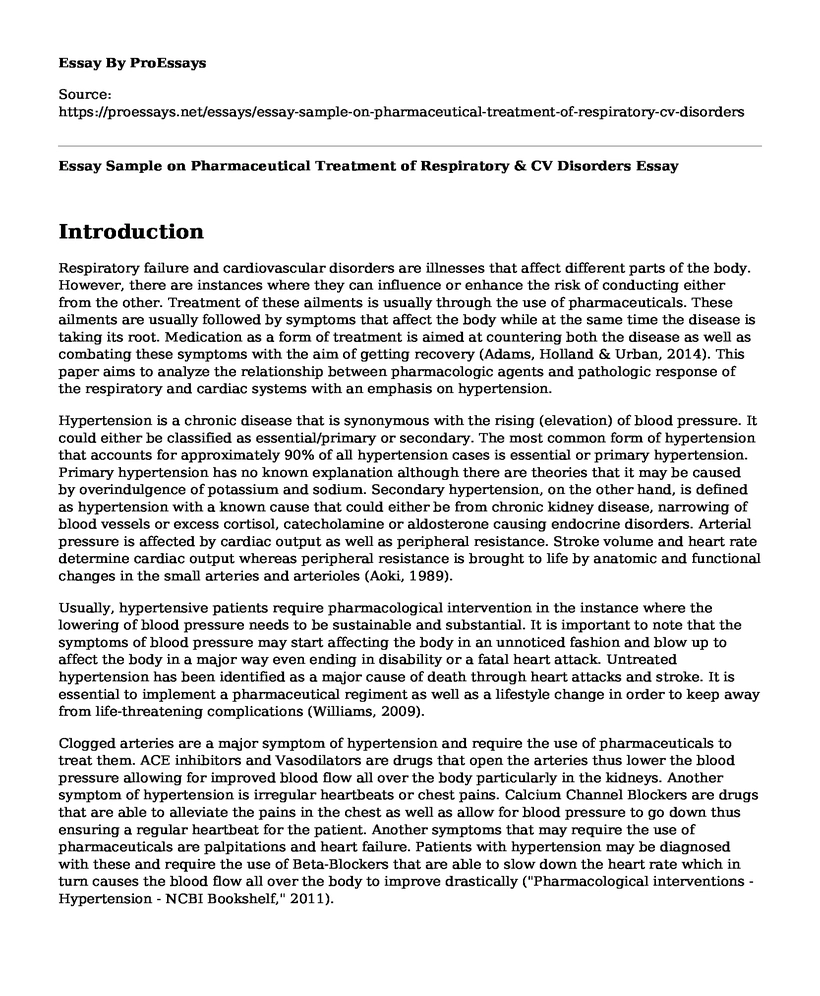Introduction
Respiratory failure and cardiovascular disorders are illnesses that affect different parts of the body. However, there are instances where they can influence or enhance the risk of conducting either from the other. Treatment of these ailments is usually through the use of pharmaceuticals. These ailments are usually followed by symptoms that affect the body while at the same time the disease is taking its root. Medication as a form of treatment is aimed at countering both the disease as well as combating these symptoms with the aim of getting recovery (Adams, Holland & Urban, 2014). This paper aims to analyze the relationship between pharmacologic agents and pathologic response of the respiratory and cardiac systems with an emphasis on hypertension.
Hypertension is a chronic disease that is synonymous with the rising (elevation) of blood pressure. It could either be classified as essential/primary or secondary. The most common form of hypertension that accounts for approximately 90% of all hypertension cases is essential or primary hypertension. Primary hypertension has no known explanation although there are theories that it may be caused by overindulgence of potassium and sodium. Secondary hypertension, on the other hand, is defined as hypertension with a known cause that could either be from chronic kidney disease, narrowing of blood vessels or excess cortisol, catecholamine or aldosterone causing endocrine disorders. Arterial pressure is affected by cardiac output as well as peripheral resistance. Stroke volume and heart rate determine cardiac output whereas peripheral resistance is brought to life by anatomic and functional changes in the small arteries and arterioles (Aoki, 1989).
Usually, hypertensive patients require pharmacological intervention in the instance where the lowering of blood pressure needs to be sustainable and substantial. It is important to note that the symptoms of blood pressure may start affecting the body in an unnoticed fashion and blow up to affect the body in a major way even ending in disability or a fatal heart attack. Untreated hypertension has been identified as a major cause of death through heart attacks and stroke. It is essential to implement a pharmaceutical regiment as well as a lifestyle change in order to keep away from life-threatening complications (Williams, 2009).
Clogged arteries are a major symptom of hypertension and require the use of pharmaceuticals to treat them. ACE inhibitors and Vasodilators are drugs that open the arteries thus lower the blood pressure allowing for improved blood flow all over the body particularly in the kidneys. Another symptom of hypertension is irregular heartbeats or chest pains. Calcium Channel Blockers are drugs that are able to alleviate the pains in the chest as well as allow for blood pressure to go down thus ensuring a regular heartbeat for the patient. Another symptoms that may require the use of pharmaceuticals are palpitations and heart failure. Patients with hypertension may be diagnosed with these and require the use of Beta-Blockers that are able to slow down the heart rate which in turn causes the blood flow all over the body to improve drastically ("Pharmacological interventions - Hypertension - NCBI Bookshelf," 2011).
Conclusion
The major risks of these drugs are that they may have serious side effects that patients need to have an understanding about. Furthermore, it is important to ensure that all the medications are taken as per the doctor's prescriptions because stopping the medication abruptly may lead to adverse risks that one may not be prepared to deal with such as withdrawals as well as resistance. It is important to have full knowledge of all the symptoms that go hand in hand with hypertension and how they affect the bodily systems. Medication should be the last resort as one should first of all invest in life changes that will cause the body to adapt to the changes that the body is going through.
References
Pharmacological interventions - Hypertension - NCBI Bookshelf. (2011). Retrieved from https://www.ncbi.nlm.nih.gov/books/NBK83273/
Adams, M., Holland, N., & Urban, C. (2014). Pharmacology for nurses: A pathophysiologic approach (4th ed). Upper Saddle River, NJ: Pearson Education Inc. (Chapters 22-31 & 38-39)
Aoki, K. (1989). Three-Way Classification of Hypertension: Gene Hypertension, Environment Hypertension, and Disease Hypertension. Essential Hypertension 2, 9-33.
Williams, B. (2009). The changing face of hypertension treatment: treatment strategies from the 2007 ESH/ESC hypertension Guidelines. Journal of Hypertension, 27(Suppl 3), S19-S26.
Cite this page
Essay Sample on Pharmaceutical Treatment of Respiratory & CV Disorders. (2022, Nov 19). Retrieved from https://proessays.net/essays/essay-sample-on-pharmaceutical-treatment-of-respiratory-cv-disorders
If you are the original author of this essay and no longer wish to have it published on the ProEssays website, please click below to request its removal:
- Health Care Organizations: Mission, Vision, Values
- Management of Postoperative Pain in Adult Surgical Patients Essay
- Why Water Quality Is an Essential Part of the Sustainable Development Goals Paper Example
- Health History and Screening of an Adolescent or Young Adult Client Paper Example
- Westbury Hospital Customer Relationship Plan - Essay Sample
- Health Care Reimbursement: Retrospective & Prospective Strategies - Essay Sample
- Essay on Cytomegalovirus: A Contagious Virus Affecting All Ages







